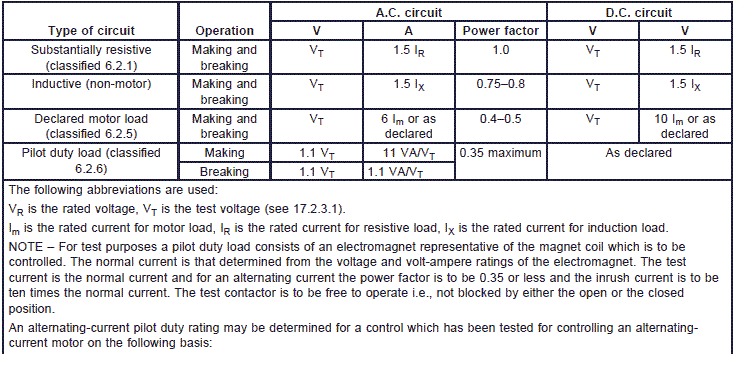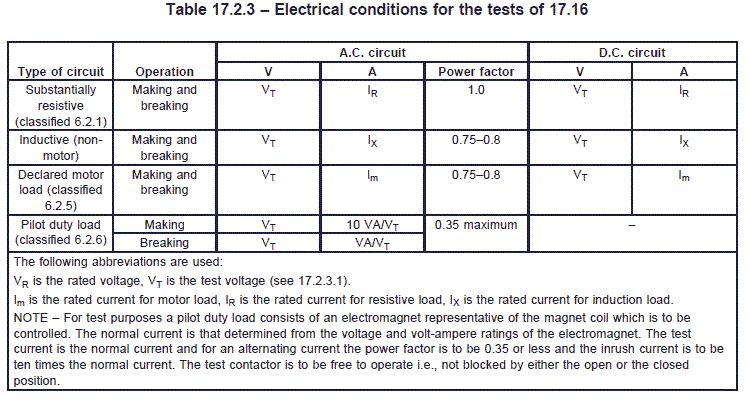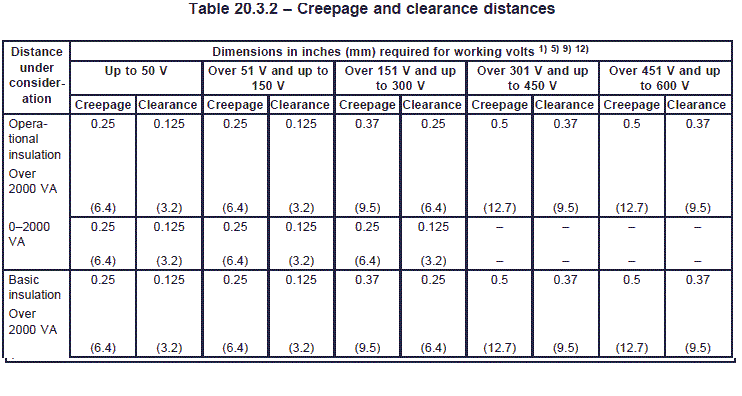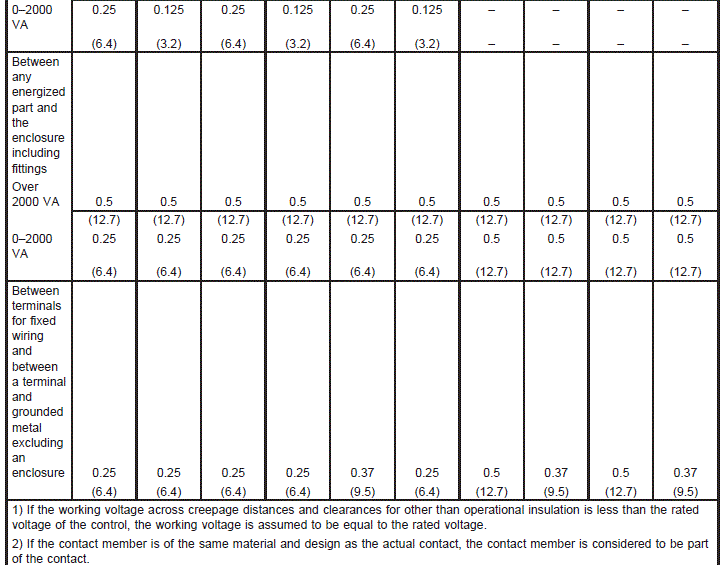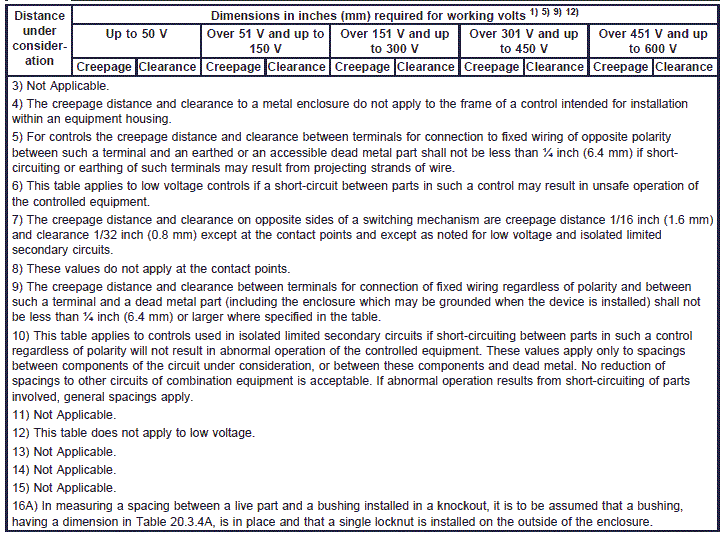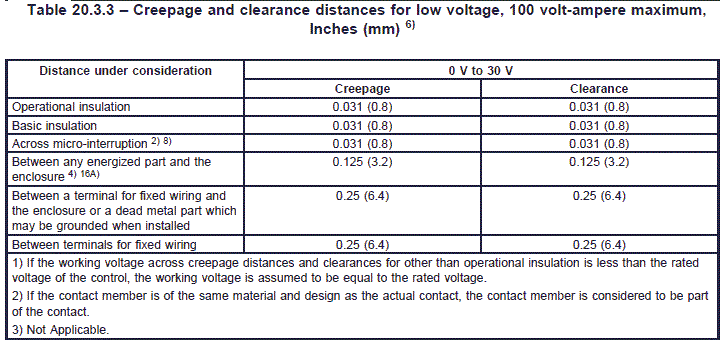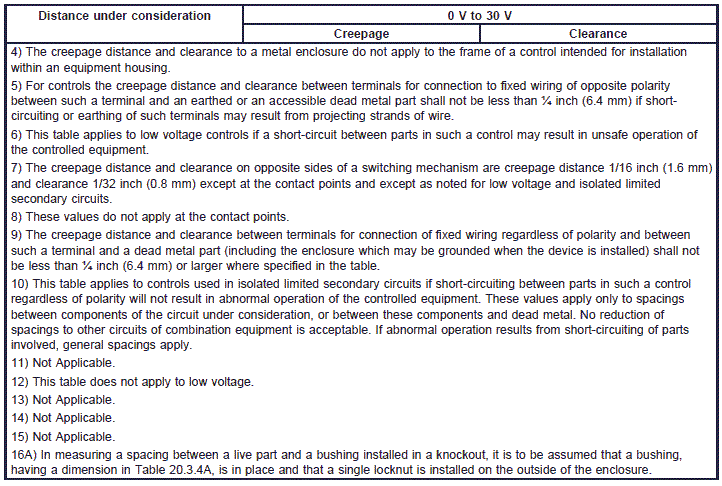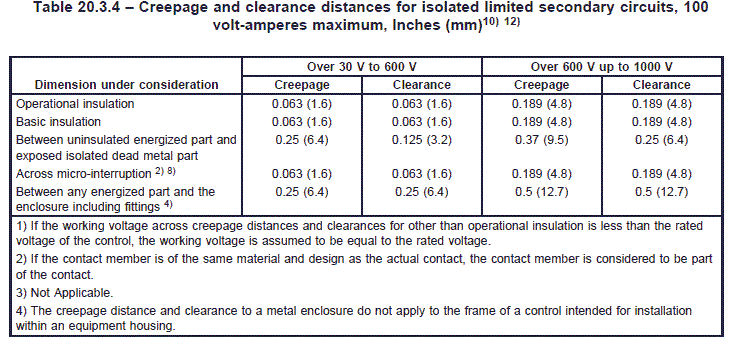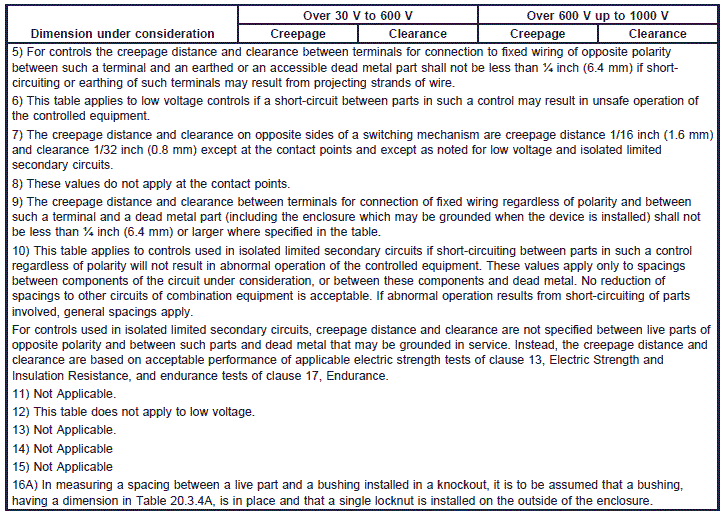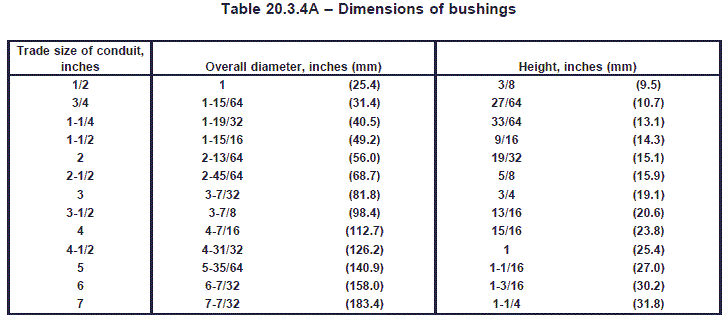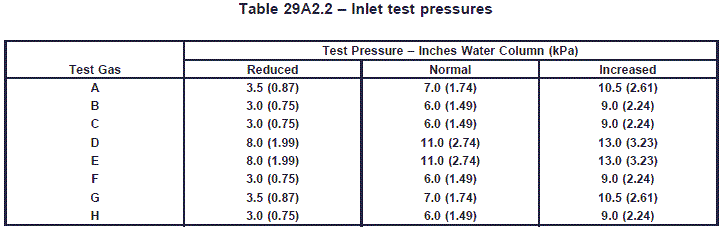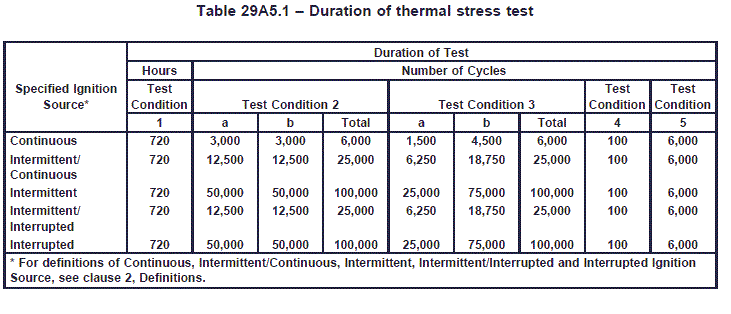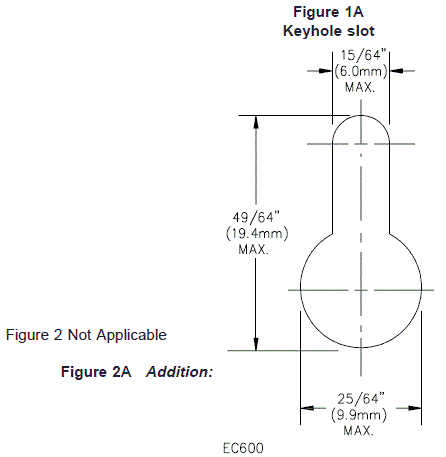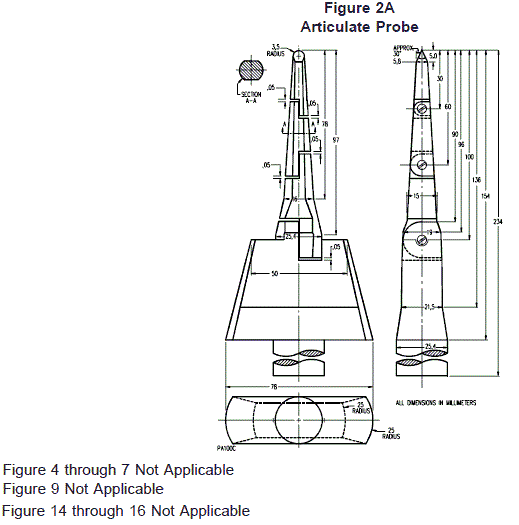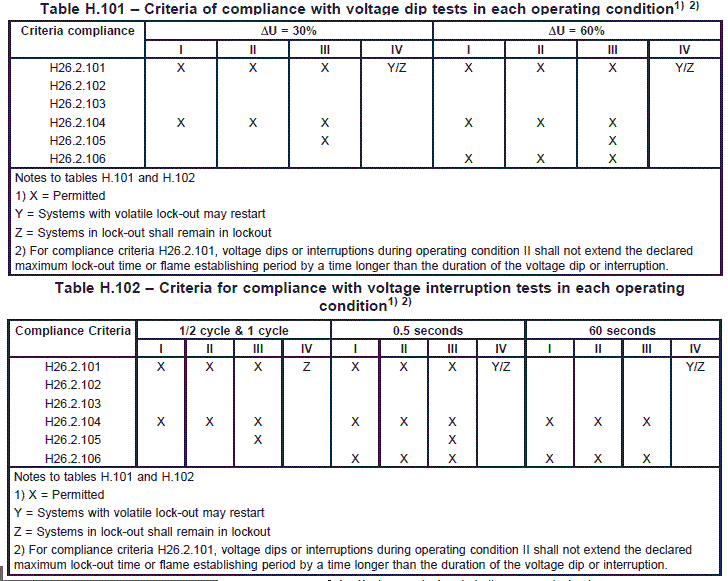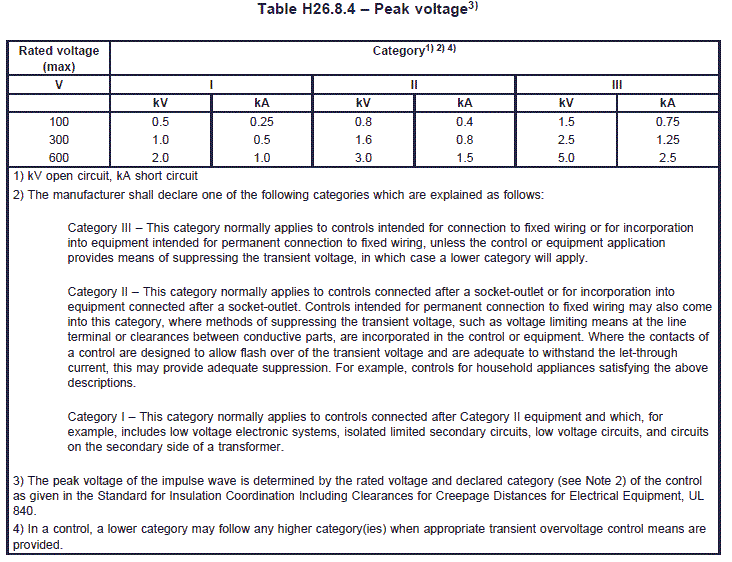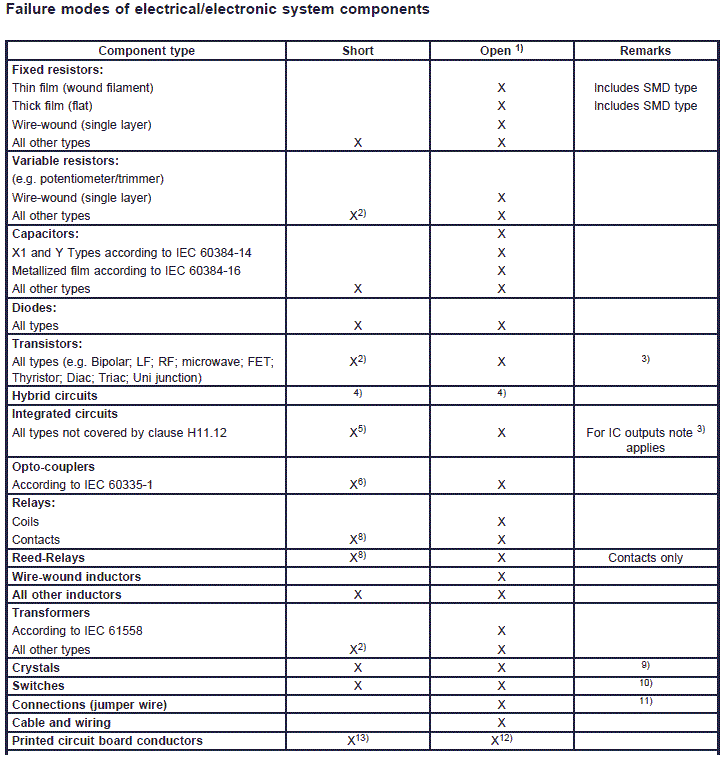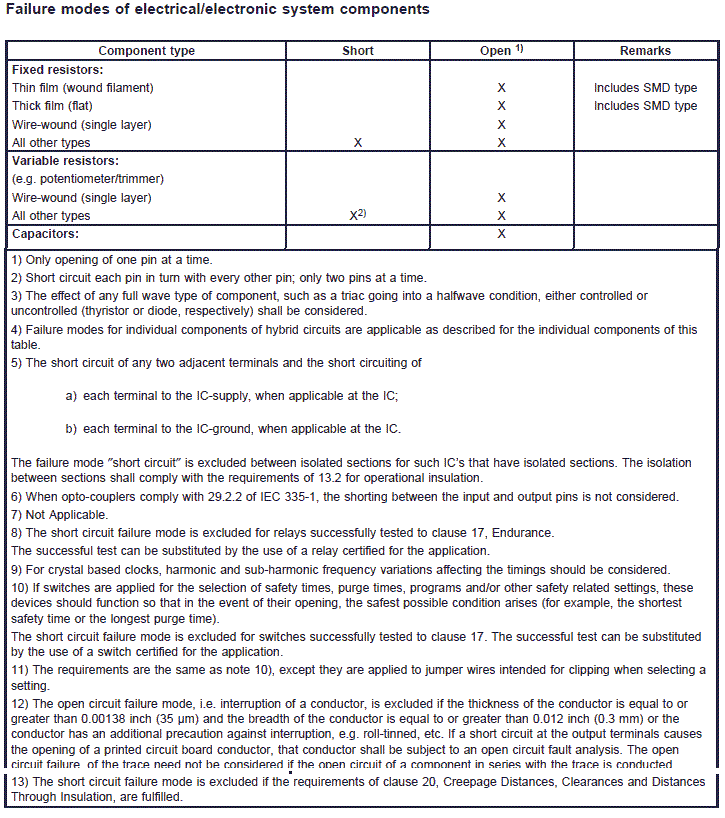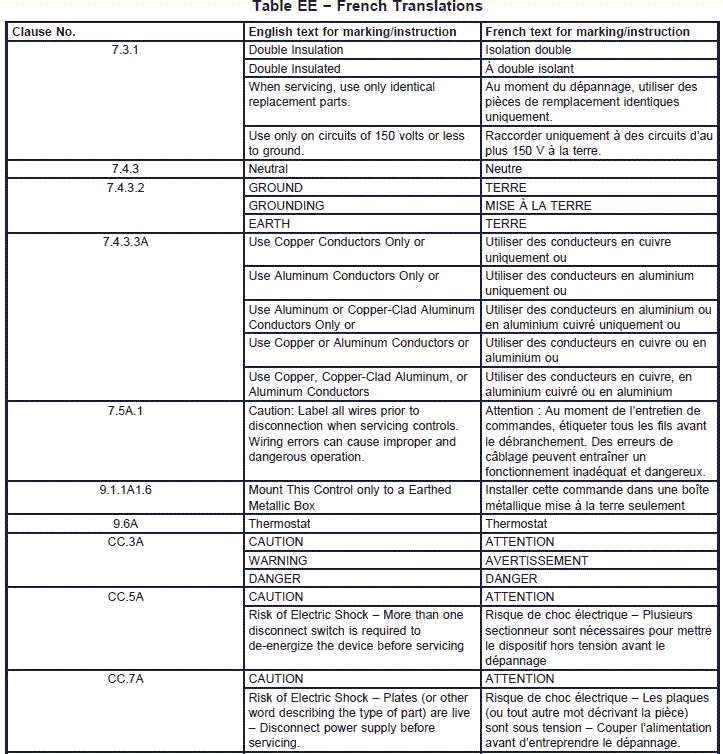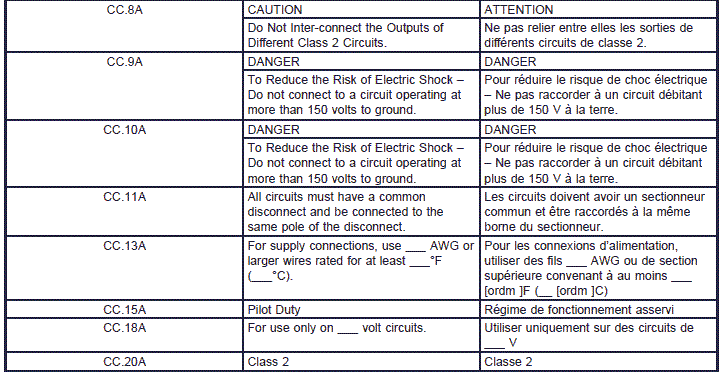
| Table 7.2 | ||
| Information | Clause or subclause | Methods: |
| 4 Nature of supply (a.c. or d.c.) | 4.3.2, 6.1 | C |
| 4A Class of transformer required | 2.1.6 | D |
| 5 Frequency, mHz | 4.3.2 | C |
| 6A Construction of control and whether the controlis electronic | H2.5.7 | X |
| 15 Degree of protection provided by enclosure 8 | 11.5 | C |
| 18 Not Applicable | --- | D |
| 20 and 21 Not Applicable | --- | |
| 22 Ambient temperature limits of the system and system components, TMIN and TMAX, | 1.1.5A, 2.3.30, 2.3.30A,14.5, 14.7, 29A |
|
| 22A Operating temperature limits of components, and points of measurement thereof, including, but not limited to the following: | 29A | |
| Pilot burner tip Pilot burner orifice fitting Electric igniter Flame sensor The surface temperature in the area of hot and cold junction ofthermoelectric types Means that determine time(s) of operation Electric component housing(s) Mechanical component housing(s) Sensing element ambient temperature limit(s) |
X | |
| 23 through 29 Not Applicable | --- | --- |
| 31 Method of Installing the system and eachcomponent 5) |
4.1.1, 11.6, 17.16.105 | D |
| 32 through 44 Not Applicable | --- | --- |
| 46 Operating sequences | 2.3.13, 11.3.108, 15 | D |
| 47 and 48 Not Applicable | --- | --- |
| 51 Not Applicable | --- | --- |
| 61 through 65 Not Applicable | --- | --- |
| 101Maximum flame detector response time (if applicable) |
2.3.103, 15 | D |
| 102 Minimum flame detector self-checking rate (if applicable) |
2.3.106, 15 | D |
| 103 Maximum flame failure lock-out time (if applicable)
|
2.3.107, 15 | D |
| 104 Maximum flame failure reignition time (if applicable) |
2.3.108, 15 | D |
| l04A Maximum flame failure response time (if applicable) |
2.3.108A, 15 | D |
| 105 Not Applicable | D | |
| 106 Maximum trial for ignition period (if applicable) | 2.3.113A, 15 | D |
| 107 Maximum pilot-flame establishing period (if applicable) |
2.3.114, 15 | D |
| 108 Maximum post-ignition time (if applicable | 2.3.115, 15 | D |
| 109 Maximum pre-ignition time (if applicable) | 2.3.116, 15 | D |
| 110 Void | D | |
| 110A Minimum inter-purge time (if applicable) | 2.3.118.3A | D |
| 111 Minimum post-purge time (if applicable) | 2.3.118.1, 15 | D |
| 112 Minimum pre-purge time (if applicable) | 2.3.118.2, 15 | D |
| 113 Minimum recycle time (if applicable) | 2.3.120, 15 | D |
| 114 Maximum lock-out time (if applicable) | 2.3.125A, 15 | D |
| 115 Minimum waiting time (if applicable) | 2.3.126A, 15 | D |
| 115A Maximum ignition activation period (if applicable) | 2.3.129A | D |
| 115B Minimum automatic restart time (if applicable) | 2.3.130A, 15 | D |
| 116 Not Applicable | D | |
| 117 Type of pilot | 2.101.2, 2.101.4, 2.101.7, 2.101.9 |
D |
| 118 Type of ignition | 2.101 | D |
| 119 Void |
D | |
| 120 Means of protecting settings of timings | 11.3.4 | X |
| 121 See annex H |
D | |
| 122 Resistance to vibration | 17.1.3, 17.16.10 | D |
| 123 S1 (signal for presence of flame, if applicable) |
2.3.104.1, 15.5, 15.6, 15.7 | D |
| 124 S2 (signal for absence of flame, if applicable) |
2.3.104.2, 15.5, 15.6, 15.7 | D |
| 125 Smax (maximum flame signal, if applicable) 103) | 2.3.104.3, 15.5, 15.6, 15.7 | D |
| 126 Electronic Ignition spark gap 102) | 13.2.101 | D |
| 127 Other system components used with the submitted components to provide a complete system |
2.2.101, 2.2.102, 2.2.104, 2.2.106 |
D |
| 128 Not Applicable | ||
| 128A For oxygen depletion safety shutoff systems, maximum and minimum oxygen cutoff points. |
2.111.4A, 29A3.5 | X |
| 128B For a thermoelectric type flame sensor: – available lead length(s) (nominal); – minimum and maximum electrical resistance for each lead length. |
29A4.3.2 | X |
| 128C For thermoelectric devices: – minimum and maximum electrical resistance; – minimum and maximum pull-in current. – minimum and maximum drop-out current. |
29A4.3 | X |
| 128D Element ambient temperature limit |
2.111.1A, 29A4.2.1 | X |
| 129 Maximum valve sequence period (if applicable) |
2.3.128, 11.3.112, 15.5q | D |
| 129A Date code. | 7.4.6A | C |
| 130 Not Applicable. |
||
| 130A Certifying agency symbol. |
7.4.7A | C |
| 131 For proved igniters, the characteristics (energy,current, voltage, resistance, temperature, etc.) which establish that the proved igniter is capable of igniting the fuel |
23.117, 15.3, 15.4, 15.5, 15.7 |
D |
| 131A Whether the ignition system component is intended for direct exposure to flame envelopment. |
29A5(c) | D |
| 132 Proved igniter operating value (Minimum or maximum, as applicable) |
2.3.117.1, 15.7, 17.16.108, H27.1.3 |
D |
| 132A Fuel for which intended. | 6.101 | D |
| 133 Maximum igniter proving time (If applicable) |
2.3.117.2, 15.5 | D |
| 133A Gas input rate for pilot burners. |
29A2.4.4 | D |
| 134 Maximum igniter failure response time (If applicable) |
2.3.117.3, 15.5 | D |
| 134A A failure mode and effects analysis (FMEA). 104A) |
H27 | X |
| 135A Documentation relative to the suitability of materials. |
11.1, 29A2.1.3, 29A2.1.4 |
X |
| 136A Complete instructions for lighting, operating and field adjustments and electrical diagrams indicating external connections. |
7.4.4 | D |
| 137A Instruction per 7.5A. |
7.5A | D |
| 138A Markings per 7.4.8A. |
7.4.8A | C |
| 139A Markings per 8.1 (if applicable) | 8.1.101 | C |
| NOTES 3) and 4) Not Applicable 6) Not Applicable 8) Control enclosures shall be marked in accordance with the environmental enclosure requirements of UL 50 or CSA C22.2 No. 94. Dust covers are not considered to be control enclosures, and need not be marked. 10) and 11) Not Applicable. 20) and 21) Not Applicable. 101) Not Applicable 102) If a range is declared, the maximum value is used for the test of 13.2.102 and 13.2.103. 103) Smax shall be declared for those controls in which the maximum flame signal affectstimings or sequence. 104A) Typical FMEA form shown in Appendix B, Failure Mode and Effect Analysis. |
||

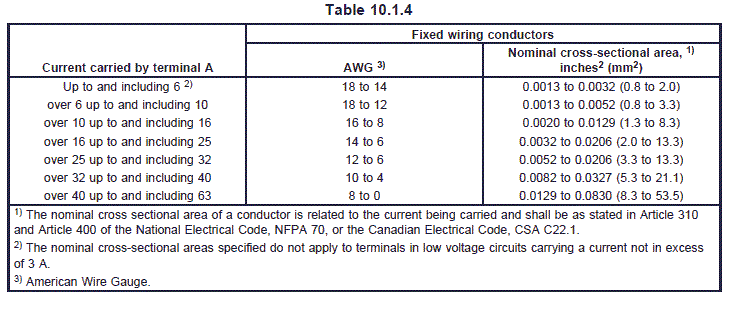
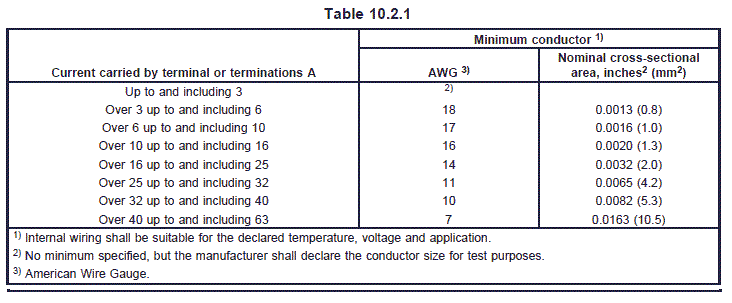


Parts |
Maximum Temperature permitted 9) °F(°C) |
|---|---|
Pins of appliance inlets and plug-in devices 1): |
|
– for hot conditions |
311 (155) |
– for very hot conditions |
248 (120) |
– for cold conditions |
149 (65) |
Windings 8) 9) 10) 11) 13) and core laminations in contact therewith, if winding insulation is: |
|
– of class A material |
212 (100) [194 (90)] |
– of class E material |
239 (115) [221 (105)] |
– of class B material |
248 (120) [230 (110)] |
– of class F material |
284 (140) |
– of class H material |
329 (165) |
Terminals and terminations for external conductors 1)7)C) |
185 (85) |
Other terminals and terminations 1) 2) |
185 (85) |
Rubber or polyvinyl chloride insulation of conductors 1): |
|
– if flexing occurs or is likely to occur |
140 (60) |
– if no flexing occurs or is unlikely to occur – |
167 (75) |
with temperature marking or temperature rating |
value marked |
Cord sheath used as supplementary insulation |
140 (60) |
Rubber other than synthetic when used for gaskets or other parts, the deterioration of which could impaircompliance with this standard 12) A): |
|
– when used as supplementary insulation or as reinforced insulation |
149 (65) |
– in other cases |
167 (75) |
Materials used as insulation other than for wires 3)5) 12): |
|
– impregnated or varnished textile, paper or press board |
203 (95) |
– laminates bonded with: melamine formaldehyde, phenol-formaldehyde or phenolfurfural resins |
230 (110) [392 (200)] |
– urea formaldehyde resins |
194 (90) [347 (175)] |
– mouldings of 3): |
|
phenol-formaldehyde, with cellulose filters |
230 (110) [392 (200)] |
phenol-formaldehyde, with mineral filters |
230 (110) [392 (200)] |
phenol-formaldehyde, with mineral filters |
275 (135) |
melamine-formaldehyde |
212 (100) [347 (175)] |
urea-formaldehyde |
194 (90) [347 (175)] |
polyester with glass fiber reinforcement |
275 (135) |
pure mica and tightly sintered ceramic material when such products are used as supplementary or reinforced insulation |
797 (425) |
other thermosetting materials and all thermo-plastic material 4) |
– |
All accessible surfaces except those of actuating members, handles, knobs, grips and the like |
185 (85) |
Accessible surfaces of handles, knobs grips and the like use for carrying and transporting the control B): |
Not Applicable |
Accessible surfaces of actuating members, or of other handles, grips or the like which are held for short periods only: |
|
– of metal |
140 (60) |
– of porcelain or vitreous material |
158 (70) |
– of moulded material, rubber or wood B) |
185 (85) |
Wood in general |
194 (90) |
Supporting painted plywood surfaces |
185 (85) |
Current carrying parts made of copper or brass 1) |
446 (230) |
